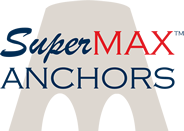The Super MAX Anchor has always performed well in anchor testing. Anchor testing is done under controlled situations which is critical for fair comparisons. However, the consumer needs to consider information about the controlled anchor tests.
- The sponsor of the test. If an anchor company sponsors a test and if there are no other independent agencies verifying the testing protocol and results.
- Which anchors are and are not included in the test. In recent tests the Super MAX Anchor was not included. This was a test in seabeds that the Super MAX is known to obtain superior setting and holding results.
- Replication of actual anchoring conditions and situations. This is especially true for anchors that are designed to continue to dig deep into the seabed. The process of setting deeply does not happen quickly. It takes time and occurs when the anchor is subjected to routine strains on the load followed by easing of the load (the action of wind gusts, current shifts, wave action, etc). As this happens over and over, these anchors go deeper into the seabed. Deep setting anchors build a significant amount of seabed between their flukes and the seabed surface. The Super MAX anchor’s unique concave shape, with one of the largest fluke areas of any anchor in the industry, captures even more substrate.
The Super MAX anchor is a penetrating anchor with an initial setting/holding of approximately 700 pounds for mid-size anchors. If at anchor, and with steady winds increasing in strength, the anchor will penetrate possibly 20 feet below the bottom’s surface in softer seabed substrates. the results of that action dramatically increases the holding of the anchor.
In anchor tests that I have reviewed, the anchors are set and immediately the holding pressure is recorded in pounds. The test vessel then applies continuous force on the load and records the pressure when the anchor drags or gives way, ending the anchor test. Since it is only a few minutes per anchor, this does not replicate a real life anchoring situation. If a test vessel would replicate wind and current stresses that are more naturally occurring (stress the ground tackle, relax, stress the ground tackle, relax, etc) before the holding tension is recorded, deep digging anchors would have the chance to dig deep into the seabed and reveal their real holding power.
Verification of the seabed strata is a second issue. As you move away from excellent holding substrates such as sand, seabeds can change within a small location. Mud can be sticky, firm, soft, soupy, and ooze and often these different consistencies are close in proximity. Lucky for the anchor that gets the firmer mud in a soft bottom test verses the soupy mud of another. Unless the test includes a diver to verify the consistent seabed, the results may be compromised.
Testimonials from actual users may be much more accurate in describing an anchor’s performance, however, this must be read with caution as well. Look for more than one example of an anchor holding in certain conditions. For example, a captain with a particular anchor on his boat may claim it held the vessel firm in hurricane winds over 150 knots. That captain then becomes an endorser for that anchor. No one doubts the story because others have documented that the vessel was anchored during the hurricane and clearly the vessel was unscathed after the storm. The anchor company then sells hundreds of anchors as a result of this one endorsement. But when investigated by an independent agency, they find the anchor was hooked onto a cable under the surface of the strata. In an other example, an anchor company claims a specific holding power for each model, as per their testing. That data may be voided by someone who bought that company’s anchor because of that testing and documented one extraordinary event that actually was not accurate. That new anchor owner comes back to state, “my anchor only held a paltry 200 rpms on my engine or maybe 100 pounds of stress.” The real truth about the anchor is probably somewhere in the middle of these two extremes. At the very least, make sure there is more than one testimonial on an anchor’s performance in similar conditions. Look for testimonials from captains of vessels similar to your vessel. A power vessel with a flybridge enclosure will provide a much different load an anchor as a sleek sailing vessel.
The Super MAX Anchor has always performed well in anchor testing and the testimonials from their users verifies the easy setting and holding power. Their testimonials demonstrate even stronger holding over hours at anchor. For more information on the Super MAX Anchor, contact us at steve@maxmarineproducts.com or by calling 1-855-943-8262.
